Turismo versus pesca artesanal. A propósito de La Reserva Marina de la Isla de La Graciosa y los Islotes del Norte de Lanzarote
Fecha
2004Resumen
La Reserva Marina de La Graciosa y los Islotes del Norte de Lanzarote (RMLGINL) se creó
en 1995 y, desde entonces, las actividades pesqueras de la población local y su cultura del mar han ido
decreciendo progresivamente mientras que las actividades turísticas siguen emergiendo como la panacea
en una pequeña isla, como La Graciosa, con no más de 600 habitantes. En este artículo tratamos de analizar
cómo estos dos procesos están relacionados y qué papel está jugando la reserva marina en este caso.
Usamos no sólo información cualitativa de los pescadores locales y de sus grupos domésticos, sino también
cuantitativa contrastando algunos parámetros concretos como el número de pescadores y los barcos
de pesca activos, los negocios relacionados con el sector servicios (restaurantes, apartamentos, etc.),
antes y después de implementación de la reserva marina. En este sentido, un importante elemento es la
percepción de esta institución desde la población local, y la evolución de su actitud a favor o en contra.
Estos procesos están relacionados con el diseño institucional de las reservas marinas en las Islas Canarias,
en donde la participación de las poblaciones pesqueras locales está severamente limitada. The Marine Reserve of La Graciosa Island and the islets of the North of Lanzarote was created
in 1995 and, since then, the fishing activities of the local population and their local culture of the sea
have been decreasing progressively while tourist activities are emerging as the panacea in a little island
as La Graciosa with no more than 600 inhabitants. In this paper we try to analyse how these two processes
are linked and what role is playing the local marine protected area in this case. We use not only
qualitative information from fishers and their domestic units, but also quantitative data contrasting some
objective parameters as the number of fishers and active fishing boats or service related business (restaurants,
apartments, etc.), before and after the implementation of the marine reserve. In this sense, an important
element is the perception of this institution from the local population, and the evolution of their
attitude in favour or against it. These processes are related to the institutional design of the marine reserves
in the Canary Island, where the participation of local fishing populations is severely limited.






